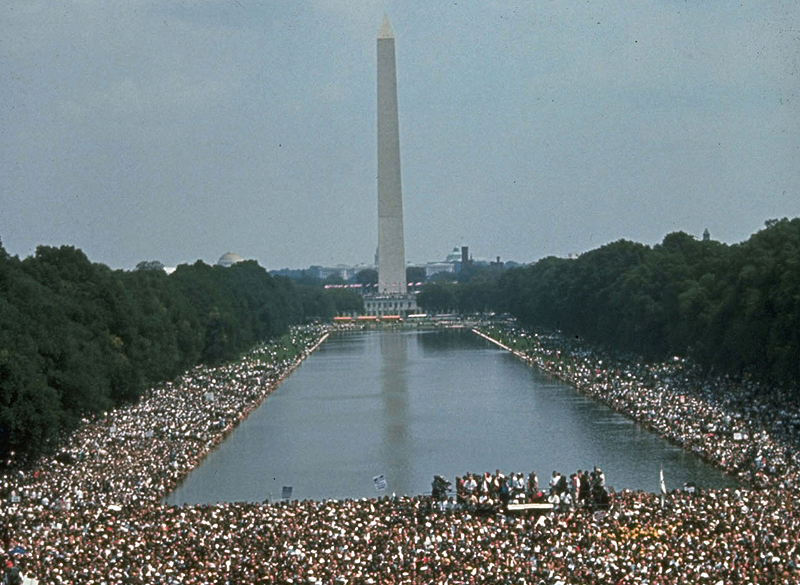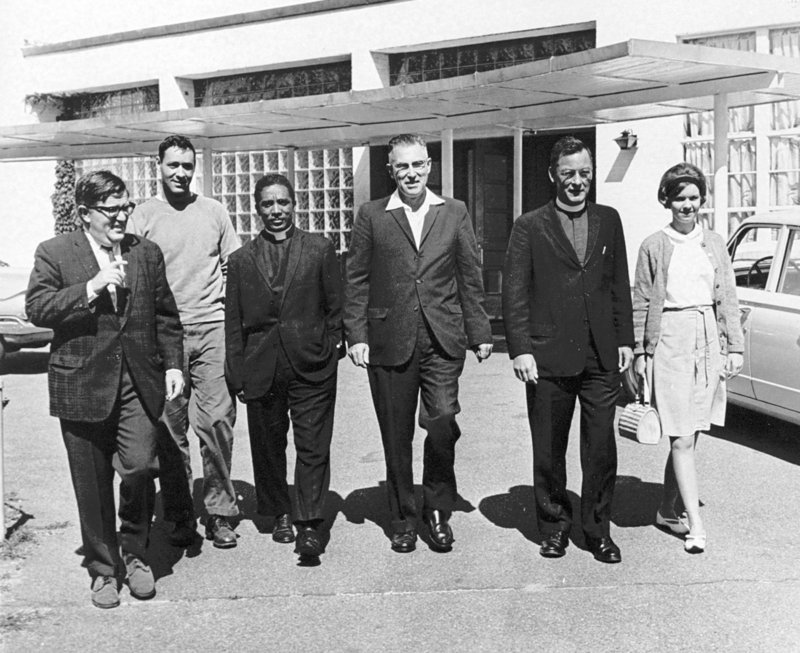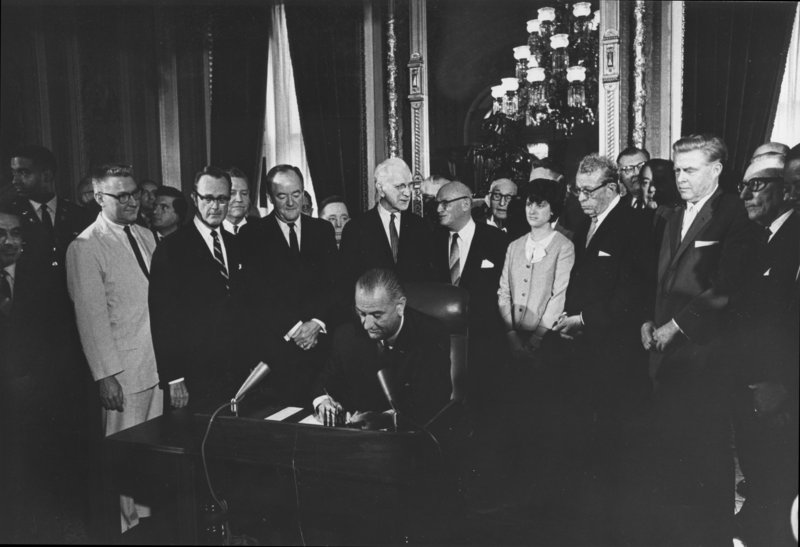Rabbi Harry Sky’s congregants at his synagogue, Temple Beth El, begged him to go.
Harold Pachios’ former editor at the Evening Express asked him to cover it for the newspaper.
Michael Grunko got permission from his parents, and Gerald Talbot received the blessing of both his wife and his boss.
Fifty years ago Wednesday, the four men from Maine joined more than 200,000 people who packed the space between the Washington Monument and the Lincoln Memorial for an unprecedented rally for civil rights that changed the course of history — and their lives.
The March on Washington for Jobs and Freedom was organized to draw attention to civil rights and economic issues. The next year, the Civil Rights Act was passed, making racial and other forms of discrimination illegal.
Sky first heard it was happening while in the capital for a rabbinical convention. He talked about it during the service at his Portland synagogue the next week, and members of the congregation came up to him afterward.
“They said, ‘Rabbi, you have to go,’” Sky, 89, recalled last week.
When he told them he couldn’t afford the trip, they insisted on paying his way.
Pachios, who grew up in Cape Elizabeth, was already in Washington, working as deputy congressional liaison for the Peace Corps and going to law school at night at Georgetown University. He got a call from an editor at the Portland newspaper where he briefly worked after college, asking if he was planning to attend the march.
“He said, ‘Can you give us some coverage?’” said Pachios, 77. The young Pachios agreed and did call in a story to the Evening Express.
Grunko, then a rising senior at Bangor High School, also got a call — from the National Association for the Advancement of Colored People — asking him to be the Maine youth representative for the organization.
Grunko had joined the NAACP almost by accident after seeing a poster at the University of Maine, where he was taking lessons to correct a stutter. He wrote to the group seeking more information about the organization and was sent back a membership application.
After he joined, he didn’t hear much more from them until he got the call that summer.
“I said, ‘Sounds good to me, but I’ve got to talk to my parents,’” said Grunko, 67.
They had cause to be concerned. That spring, young protesters in Birmingham, Ala., were attacked by police officers with clubs and high-pressure hoses.
Grunko first appealed to his father, a Polish immigrant with “a strong sense of history,” he said. “I convinced him I should go on this march, and we convinced my mom.”
For Talbot, approval first had to come from his wife, who would be left alone to take care of their three daughters, all younger than 6 years old.
Anita Talbot said she was concerned for his safety, because there was talk that the march could turn violent, but she believed it was her husband’s calling.
“He really needed to go,” she said.
Talbot also needed permission from his boss at the Portland printing company where he worked almost every day. Much to Talbot’s surprise, his boss gave him the time off.
The night before the march, Grunko took a Greyhound bus from Bangor to Lewiston, where he got in a car that stopped in Portland to pick up more people going to the march, including Sky, and headed to Boston. Talbot, too, carpooled to Boston, where they all got on buses that took them to Washington.
As they traveled south through the night, more buses coming from Massachusetts, Rhode Island and Connecticut joined the caravan, lining the highways and overwhelming the Howard Johnson’s restaurants, where they stopped for bathroom breaks along the way.
Churches in Baltimore awaited their arrival with breakfast for the travelers before the final leg of their trip.
In Washington, the march shut down the city, said Pachios. Offices were closed and parking was banned.
“Buses were lining every street,” he said.
Police were everywhere, too. There was a fear that, with so many people, the march would get out of control. But it never came close.
Pachios said the whole day was “extraordinarily upbeat,” with people smiling and singing.
“It was like riding on a cloud,” Grunko said.
Talbot described it as a giant picnic.
It was a long day with a full program of performers, including Joan Baez and Bob Dylan, and 18 speakers — most notably, of course, Dr. Martin Luther King Jr.
By the time King got up to deliver his iconic “I Have a Dream” speech, the crowd was weary from standing in the sun for so long, Talbot said. But the mood soon changed.
“It woke everybody up,” he said. “They came to life.”
Pachios was standing just below the Lincoln Memorial near the end of the reflecting pool. From there, he could see King, although he looked small, especially compared with the huge sculpture of Lincoln looming behind him.
“The symbolism of doing this at the Lincoln Memorial was, frankly, overwhelming,” Pachios said.
Sky remembers looking around at what first seemed like just a sea of faces. Then, suddenly, he said, they became human to him.
“I felt like I was in the middle of a great happening,” Grunko said.
At the time, though, the men couldn’t have guessed how major that moment in history was.
“I did not realize that I would be here 50 years later to celebrate something that I took part in because I believed in it and still do,” Talbot said.
The march, Sky said, “opened the door to all of the change that has come about since then.”
It also had a profound personal effect on those who were there.
“It influenced my life and made me feel involvement and activism and taking a stand and being willing to take criticism because you believed in something was OK,” said Grunko, who got involved in Democratic Party politics and served as president for the local Service Employees International Union in Massachusetts, where he now lives.
Grunko planned to leave Friday for Washington to participate in the anniversary celebration of the march with his wife and 11-year-old grandson.
“I’m going to hand him the torch,” he said.
At the time of the march, Pachios was already on a path toward political involvement. He served on the presidential campaign staff of Lyndon Johnson and later worked as his associate press secretary. He was also on the campaign staff of Maine Sen. Edmund S. Muskie when he won the Democratic nomination for vice president in 1968.
Pachios later returned to Maine, where he became a founding partner of the Portland law firm Preti Flaherty Beliveau & Pachios and served as chairman of the state Democratic Party.
Sky returned to Portland from Washington and got to work organizing a local chapter of the NAACP. A couple of years later, he found himself in the presence of King again, this time sharing the pulpit with him at a rally in Selma, Ala.
Now living in North Carolina, Sky still stays in touch with Talbot, who became the local president of the NAACP. Talbot was also elected to the Maine House of Representatives, the state’s first black legislator. His daughter, Rachel Talbot Ross, is now president of the NAACP’s Portland chapter.
Talbot said he returned from Washington after the march knowing he had to figure out how to strengthen the black community in Portland.
“That day, I will say, changed my whole life,” he said.
Leslie Bridgers can be contacted at 791-6364 or at:
lbridgers@pressherald.com
Send questions/comments to the editors.







Comments are no longer available on this story